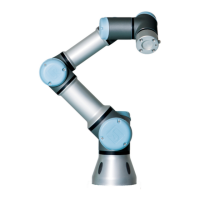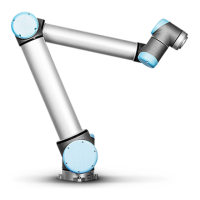10.7 Freedrive Mode
limits:
Normal mode: The safety mode that is active by default;
Reduced mode: Active when the robot TCP is positioned beyond a Trigger Reduced
mode plane (see 10.12), or when triggered using a configurable input (see 10.13).
Recovery mode: When the robot arm is in violation of one of the other modes (i.e.
Normal or Reduced mode) and a Stop Category 0 has occurred,
1
the robot arm
will start up in Recovery mode. This mode allows the robot arm to be manu-
ally adjusted until all violations have been resolved. It is not possible to run
programs for the robot in this mode.
WARNING:
Note that limits for joint position, TCP position and TCP orientation
are disabled in Recovery mode, so take caution when moving the
robot arm back within the limits.
The subtabs of the Safety Configuration screen enable the user to define sep-
arate sets of safety limits for Normal and Reduced mode. For the tool and joints,
Reduced mode limits regarding speed and momentum are required to be more re-
strictive than their Normal mode counterparts.
When a safety limit from the active limit set is violated, the robot arm performs a
Stop Category 0. If an active safety limit, such as a joint position limit or a safety
boundary, is violated already when the robot arm is powered on, it starts up in
Recovery mode. This makes it possible to move the robot arm back within the safety
limits. While in Recovery mode, the movement of the robot arm is limited by a fixed
limit set that is not customizable by the user. For details about Recovery mode limits,
see the Hardware Installation Manual.
10.7 Freedrive Mode
When in Freedrive mode (see 13.1.5) and the movement of the robot arm comes close
to certain limits, the user will feel a repelling force. This force is generated for limits
on the position, orientation and speed of the robot TCP and the position and speed
of the joints.
The purpose of this repelling force is to inform the user that the current position or
speed is close to a limit and to prevent the robot from violating that limit. However,
if enough force is applied by the user to the robot arm, the limit can be violated. The
magnitude of the force increases as the robot arm comes closer to the limit.
10.7.1 Backdrive
In Freedrive mode, the robot joints can be moved with relatively little force because
the brakes are released. During initialization of the robot arm, minor vibrations
may be observed when the robot brakes are released. In some situations, such as
when the robot is close to collision, these tremors are undesirable and the Backdrive
1
According to IEC 60204-1, see Glossary for more details.
Version 3.4.5
Copyright © 2009–2017 by Universal Robots A/S. All rights reserved.
II-7 CB3

